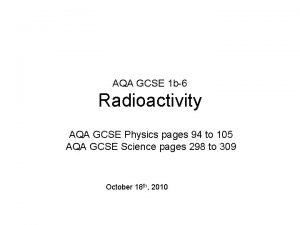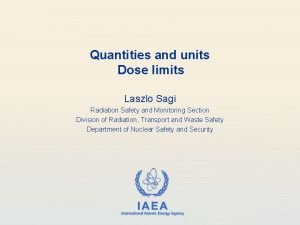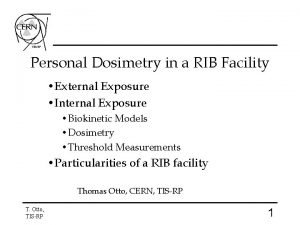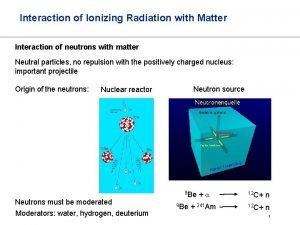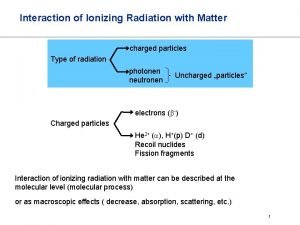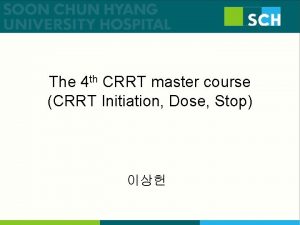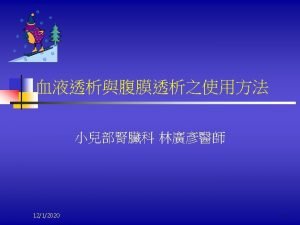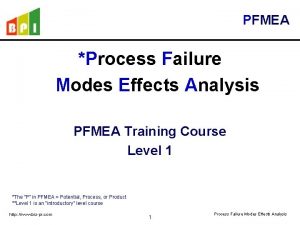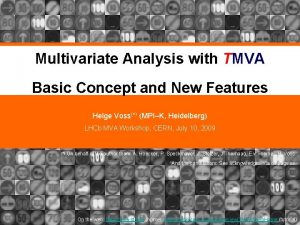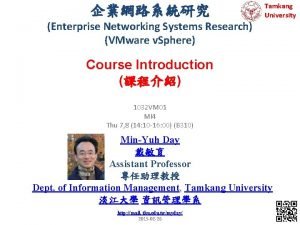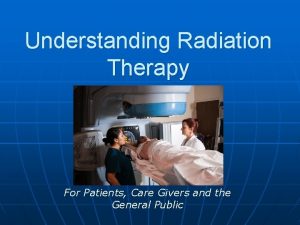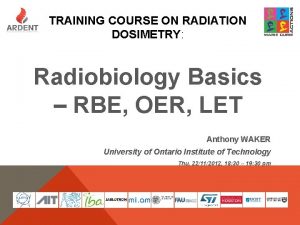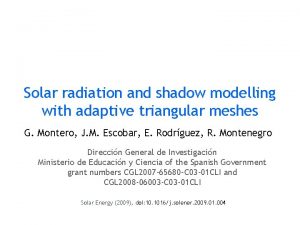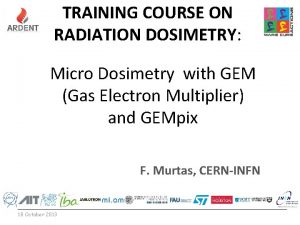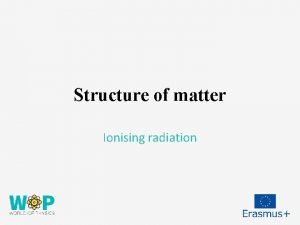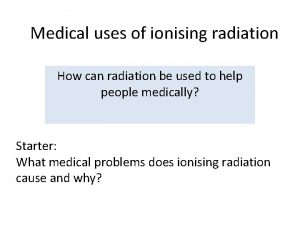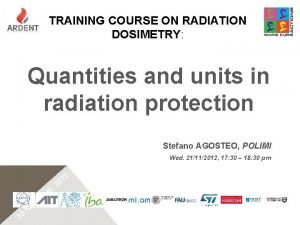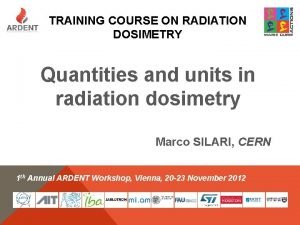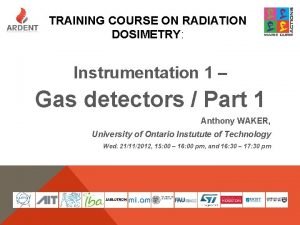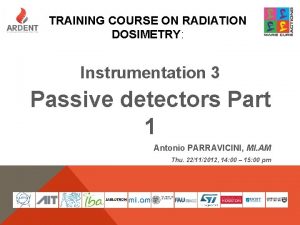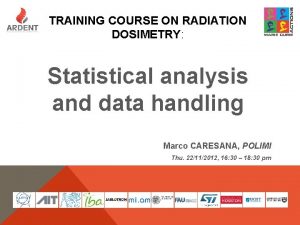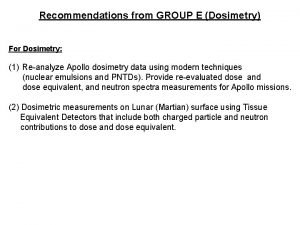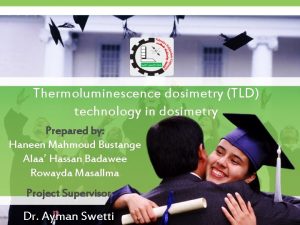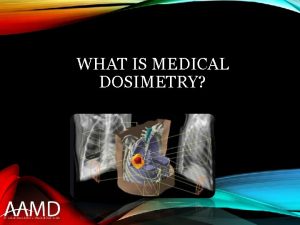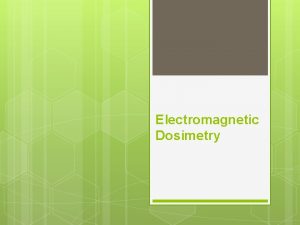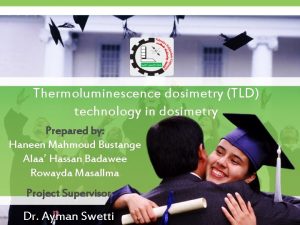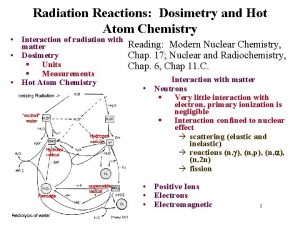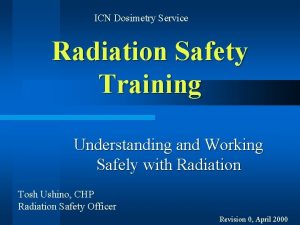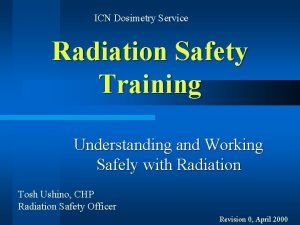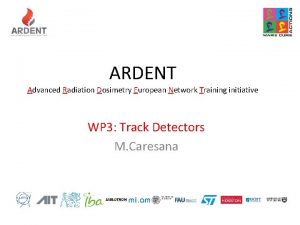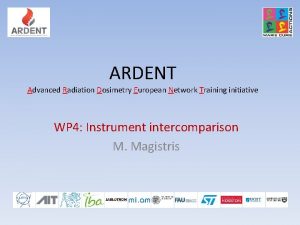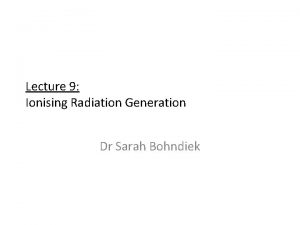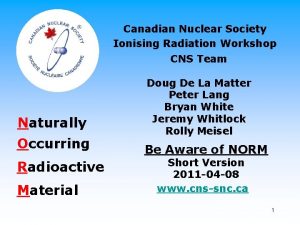TRAINING COURSE ON RADIATION DOSIMETRY Interaction of ionising


































![INTRANUCLEAR CASCADE Neutron spectral fluence [EΦ(E)] per primary hadron from 40 Ge. V/c protons/pions INTRANUCLEAR CASCADE Neutron spectral fluence [EΦ(E)] per primary hadron from 40 Ge. V/c protons/pions](https://slidetodoc.com/presentation_image/067f639b3b6fd02fbe0adcdae9cc7f25/image-35.jpg)






- Slides: 41

TRAINING COURSE ON RADIATION DOSIMETRY: Interaction of ionising radiation with matter Stefano AGOSTEO, POLIMI Wed. 21/11/2012, 10: 00 – 11: 00 am 2 r e b , 1 20 m 20 ve o N 1

CHARGED HADRONS • • • Ionization and excitation Coulomb nuclear scattering (elastic); Inelastic reactions. P V 5 Me. V protons • Stochastic and discrete behavior Courtesy of P. Colautti, INFN-LNL, Legnaro, Italy 2

IONIZATION • Energy loss (Bethe-Bloch formula): • Mean ionization potential I=(10 e. V)Z Z>16; Mean energy lost per unit path length; Continuous slowing-down approximation; • • 3

STOPPING POWER 4

IONIZATION – DENSITY EFFECT • The particle electric field: =1 • The transverse electric field of a moving particle broadens at relativistic velocities, while the longitudinal one contracts. This reflects in a collision time decrease and in an increase of the impact parameter. The latter reflects in an increase of the interaction cross section. 5

IONIZATION – DENSITY EFFECT • The electric field of a relativistic particle is higher behind than ahead its direction of motion. There is an asymmetric polarization of nearby atoms. This polarization reduces the effective electric field of the projectile and shields the atoms at higher distances which might alternatively ionized or excited by the broadening of the transverse component of the electric field. • The effect is significant when the inter-atomic distance is lower than the impact parameter for soft-collisions, i. e. in condensed materials and highpressure gases. 6

IONIZATION – ENERGY STRAGGLING • • • The Bethe-Bloch formula gives the mean energy lost per unit path length; Energy deposition by radiation is discrete and stochastic; The stochastic behavior of energy deposition in matter (energy straggling) is described by stochastic distributions such as the Landau-Vavilov distribution. 7

IONIZATION – THE BRAGG PEAK 8

SECONDARY ELECTRONS 9

COULOMB SCATTERING • • By neglecting the screening of atomic electrons; the differential x-sec for single Coulomb scattering is described by: ü where Θ is the scattering angle in the CM system and M 0 is the reduced mass. • If the projectile mass is lower than that of the target nucleus Θ θlab and M 0 M 1: • for spin zero particles (alphas, pions, …) • for spin one-half particles. • p is the projectile momentum and 10

COULOMB SCATTERING · For electrons (Mott’s formula): ü valid for high velocities (β 1) and for light materials (Z 27); 11

COULOMB SCATTERING a) 250 Me. V protons in soft tissue . c) 2 Me. V protons in soft tissue. b) 10 Me. V protons in soft tissue. d) 400 Me. V/u C ions in soft tissue 12

COULOMB SCATTERING e) 8 Me. V alphas in soft tissue. g) 5. 57 Me. V alphas in Au. f) 10 Me. V protons in Au. 13

MULTIPLE COULOMB SCATTERING · · · In an absorbing medium, a charged particle undergoes a large number of small deflections and a small number of large angle scatterings followed by small deflections. Multiple scattering is described by Goudsmit-Saunderson and Moliére. Moliere: ü valid at small scattering angles (sinθ θ) and for a collision number > 20; ü described in terms of the screening angle (the minimum angle limiting the scattering event because of the atomic electron screening of nuclei. 14

ENERGY LOSS – RADIATIVE COLLISIONS • Energy loss for electrons: • fine structure constant; 15

ENERGY LOSS B. Grosswendt, The Physics of Particle Transport: Electrons and Photons, in: The Use of MCNP in Radiation Protection and Dosimetry (1996) ENEA 16

PHOTONS – PHOTOELECTRIC EFFECT • Threshold reaction, approximately: h Atom K-shell σ= 1, L-shell σ =5, M-shell σ = 13. K-shell n = 1, L-shell n= 2, M-shell n= 3. Te = h - Be e- h << mec 2 • Characteristic X-rays and Auger electrons are emitted from atomic de-excitation. h >> mec 2 17

PHOTONS – COMPTON EFFECT • The Compton effect can be modelled by considering a free electron: e h h ’ 18

COMPTON EFFECT Klein-Nishina x-sec: • The Compton effect depends on Z 19

RAYLEIGH SCATTERING • Predominant at low energies when h <B (electron binding energy). Photons change their direction and the recoil atom absorbs a negligible amount of energy. 20

PAIR CREATION • Threshold energy 2 mec 2 1022 ke. V; h > 1022 ke. V nucleus h = (T- + mec 2) + (T+ + mec 2) e+ e- 1 << h / mec 2 << 1/137 Z-1/3 h / mec 2 >> 1/137 Z-1/3 21

PHOTONS 22

NEUTRON INTERACTIONS WITH SOFT TISSUE • Neutrons below about 20 Me. V: ü Thermal neutrons (0<E<0. 5 e. V); ü ü Epithermal neutrons (0. 5 e. V<E<100 ke. V); Fast neutrons (100 ke. V<E<20 Me. V). 23

NEUTRON INTERACTIONS WITH SOFT TISSUE • Soft tissue: Element Weight percent H 10. 2 C 12. 3 N 3. 5 O 72. 9 Na 0. 08 Mg 0. 02 P 0. 2 S 0. 5 K 0. 3 Ca 0. 007 24

THERMAL NEUTRONS Element Reaction Q (Me. V) Cross section H 1 H(n, )2 H 2. 223 332 mb C 12 C(n, )13 C 4. 946 3. 4 mb N 14 N(n, )15 N 10. 833 75 mb N 14 N(n, p)14 C 0. 626 1. 81 b O 16 O(n, )17 O 4. 143 0. 178 mb h ’ p n h n e- 25

EPITHERMAL NEUTRONS • • Neutron absorption cross sections depend on 1/v; Elastic scattering occurs and recoil nuclei can contribute to the absorbed dose. 26

FAST NEUTRONS Elastic scattering occurs and recoil nuclei contribute to the absorbed dose. • • Target Nucleus ER, max/En H 1 C 0. 284 N 0. 249 O 0. 221 Inelastic reactions: 27

FAST NEUTRONS • Some inelastic reactions: Target Nucleus Reaction Q (Me. V) Threshold Energy (Me. V) C 12 C(n, )9 Be -5. 70122 6. 18044 C 12 C(n, p)12 B -12. 58665 13. 64462 C 12 C(n, 2 n)11 C -18. 72201 20. 29569 N 14 N(n, )11 B -0. 15816 0. 16955 N 14 N(n, 2 n)13 N -10. 55345 11. 31363 O 16 O(n, )13 C -2. 21561 2. 35534 O 16 O(n, p)16 N -9. 63815 10. 24595 O 16 O(n, 2 n)15 O -15. 66384 16. 65162 12 C(n, p)12 B 28

SECONDARY RADIATION AT INTERMEDIATE AND HIGH ENERGIES • • The main mechanisms for secondary hadron production from particles other than ions at intermediate energies (from about 50 Me. V up to a few Ge. V) will be outlined. It should be underlined that for particle momenta higher than a few Ge. V/c, the hadron-nucleus cross section tends to its geometric value: • The interaction length scales with: • References: ü ü Ferrari, A. and Sala, P. R. The Physics of High Energy Reactions. Proceedigs of the Workshop on Nuclear Reaction Data and Nuclear Reactors Physics, Design and Safety, International Centre for Theoretical Physics, Miramare-Trieste (Italy) 15 April-17 May 1996, Gandini A. and Reffo G. , Eds. World Scientific, 424 -532 (1998). ICRU 28. 29

INTRANUCLEAR CASCADE • Intermediate energy reactions can be described through the intranuclear cascade model. Its main steps are: ü direct hadron-nucleon interactions (10 -23 s); ü pre-equilibrium stage; ü nuclear evaporation (10 -19 s); ü de-excitation of the residual nucleus. • Secondary particles can interact with other nuclei giving rise to an extra-nuclear cascade. 30

INTRANUCLEAR CASCADE • • Direct h-n interactions can be treated by assuming that hadrons are transported in the target nucleus like free particles interacting with nucleons with a probability ruled by free-space x-sections. Of course other more complex phenomena should be accounted for (quantum effects, effects of the nuclear field, Pauli blocking, local nuclear density, etc. ). The free-particle model can be applied for particle momenta higher than 1 Ge. V/c (i. e. above about 200 Me. V). Secondary nucleons from direct interactions are forward peaked and their energy distribution extends up to about the primary beam energy. 31

INTRANUCLEAR CASCADE • • • At intermediate energies the inelastic reactions are mainly limited to pion production: ü threshold energy: about 290 Me. V, significant production above about 700 Me. V; ü half life: 2. 6 10 -8 s ( +→ + + ) ü 0 half-life: 8. 4 10 -17 s ( 0→ 2 ). At high-energy accelerators (above tens Ge. V) muons give a significant contribution to the stray radiation field past the shield (high-energy and low LET). Neutral pions decay into two high-energy photons and may switch on an electromagnetic cascade. 32

INTRANUCLEAR CASCADE • Pre-equilibrium is a transition between the first interaction and the final thermalisation of nucleons: ü this stage occurs when the excitation energy is shared among a few nucleons; ü secondaries are forward peaked; ü the energy distribution extends up to about the maximum beam energy. 33

INTRANUCLEAR CASCADE • The last step of the INC occurs when the nuclear excitation is shared among a large number of nucleons: ü the compound nucleus has lost memory about the former steps; ü nucleons and light fragments (d, t, ) can be emitted; ü for A>16 (nuclear level density approximated to a continuum): → evaporation model; → the energy distribution can be described by a Maxwellian function (peaked at T): → the angular distribution is isotropic. • For light nuclei (A<16) other models such as the Fermi break-up model can be applied for describing secondary particle and fragment generation. 34
![INTRANUCLEAR CASCADE Neutron spectral fluence EΦE per primary hadron from 40 Ge Vc protonspions INTRANUCLEAR CASCADE Neutron spectral fluence [EΦ(E)] per primary hadron from 40 Ge. V/c protons/pions](https://slidetodoc.com/presentation_image/067f639b3b6fd02fbe0adcdae9cc7f25/image-35.jpg)
INTRANUCLEAR CASCADE Neutron spectral fluence [EΦ(E)] per primary hadron from 40 Ge. V/c protons/pions on a 50 mm thick silver target, at emission angles of 30°, 60°, 90° and 120°. Agosteo et al. NIM B 229 (2005) 24 -34. 35

INTRANUCLEAR CASCADE • After evaporation, the residual nucleus can be still in an excited state: ü if the excitation energy is lower than the binding energy of the less bounded nucleon; à the residual energy is lost through the emission of photons. ü the angular distribution of the de-excitation photons is isotropic; ü for heavy nuclei the energy spectrum can be described by a Maxwellian function; ü for light nuclei the excitation levels should be accounted for. 36

INTRANUCLEAR CASCADE • Of the various particles generated by a target bombarded by a high-energy beam only neutron, photons and muons can contribute significantly to the dose past a shield: ü protons and light fragments from evaporation are of low energy and are completely stopped in the air inside the hall (the range of a 5 Me. V proton in air is 34 cm); ü pions decay with a very short half-life; ü high-energy hadrons interact with the shielding barrier and generate secondary radiation which should be accounted for; ü The radiation field generated inside the barrier is composed by neutrons (mainly), protons, photons, electrons, positrons and pions. 37

REFERENCES • • • R. D. Evans, The Atomic Nucleus (1955) Mc. Graw-Hill. E. Segrè, Nuclei and Particles, (1964) W. A. Benjamin inc. ICRU, Microdosimetry, ICRU Report 36 (1983) ICRU, Bethesda, Maryland. ICRU, Basic Aspects of High Energy Particle Interactions and Radiation Dosimetry (1978) ICRU, Bethesda, Maryland. S. Agosteo, M. Silari, L. Ulrici, Instrument Response in Complex Radiation Fields, Radiation Protection Dosimetry, 137 (2009) 51 -73 doi: 10. 1093/rpd/ncp 186. 38

Additional Slides 39

Lethargy plots • Conservative in terms of area for semi-logarithmic plots • Therefore: • Histogram: • Lethargy (definition): 40

PARTICLE FLUENCE: COSINE-WEIGHTED BOUNDARY CROSSING The spectral distribution of particle radiance is defined as: • v=particle velocity; n=particle density (number of particles N per unit volume). The particle fluence averaged over a region of volume V can be estimated as: ü ü • nds is a “track-length density”; Tℓ sum of track lengths. The surface fluence at a boundary crossing is, for one particle of weight w: T Infinitely thin region of volume S 41
 How to calculate half life physics
How to calculate half life physics Internal dosimetry
Internal dosimetry Rib
Rib What is interaction of radiation with matter
What is interaction of radiation with matter Wkipedia
Wkipedia T junction english bond
T junction english bond Course number and title
Course number and title Course interne moyenne externe
Course interne moyenne externe Cognitive stimulation therapy training course
Cognitive stimulation therapy training course Module 7 weights and measures
Module 7 weights and measures What is tasp army
What is tasp army Training for adventurer
Training for adventurer Cabin crew training course in malaysia
Cabin crew training course in malaysia Winter driving safety presentation
Winter driving safety presentation Cognitive stimulation therapy training course
Cognitive stimulation therapy training course Fda clinical investigator training course
Fda clinical investigator training course Autotransfusion training course
Autotransfusion training course Crrt training course
Crrt training course Itcso
Itcso Crrt training course 2020
Crrt training course 2020 Pto course
Pto course Pfmea training course
Pfmea training course Asbmt clinical research training course
Asbmt clinical research training course Account reconciliation course
Account reconciliation course Analytical thinking training course outline
Analytical thinking training course outline Responsible beverage service training
Responsible beverage service training Accounts payable training course
Accounts payable training course Tmva user guide
Tmva user guide Vcda vmware
Vcda vmware Training is expensive without training it is more expensive
Training is expensive without training it is more expensive Metode of the job training
Metode of the job training Aggression replacement training facilitator training
Aggression replacement training facilitator training Grid controlled x ray tube
Grid controlled x ray tube Nhti radiation therapy
Nhti radiation therapy Radiation therapy side effects
Radiation therapy side effects Heat energy transfer
Heat energy transfer Oer radiation
Oer radiation Repetition rhythm fashion
Repetition rhythm fashion Greenhouse effect long and shortwave radiation
Greenhouse effect long and shortwave radiation Sunscreen classification
Sunscreen classification Solar radiation has a part in the water cycle by
Solar radiation has a part in the water cycle by Reflected radiation formula
Reflected radiation formula
